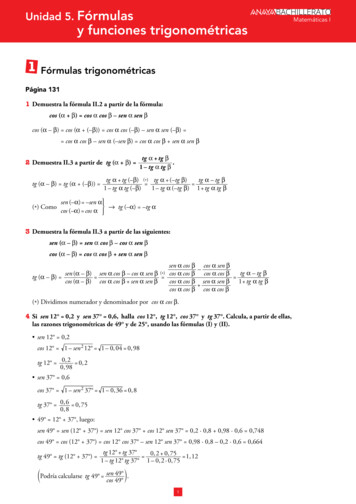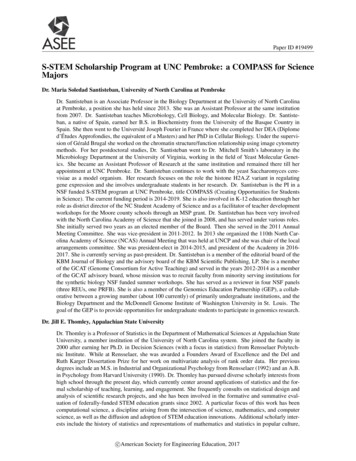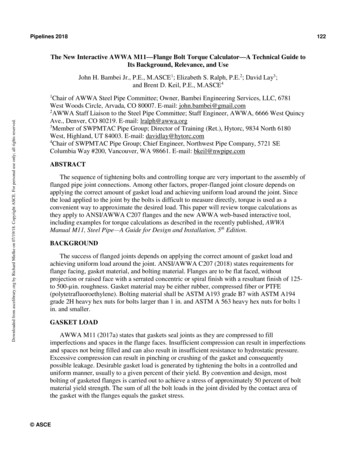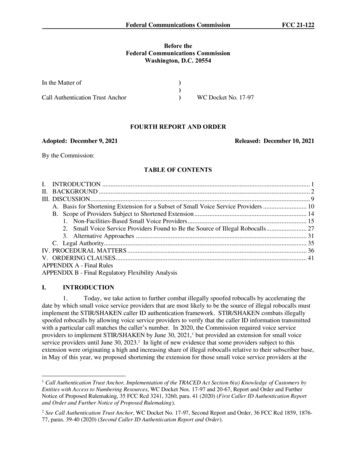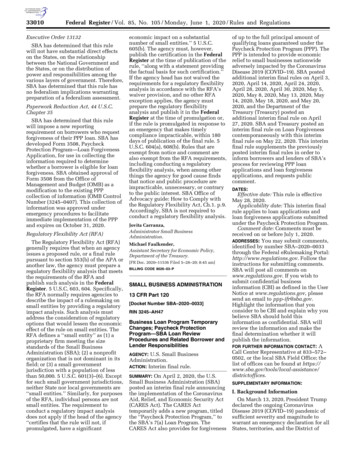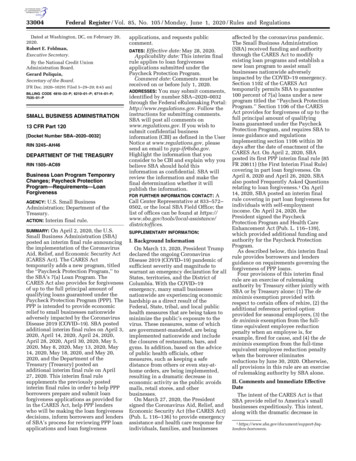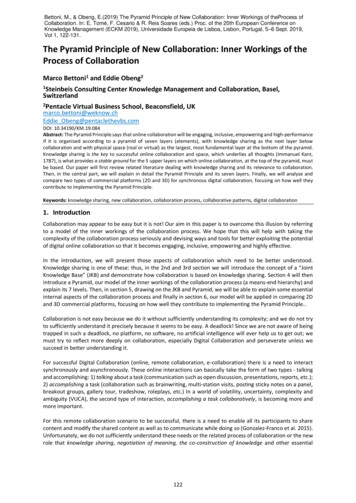
Transcription
Bettoni, M., & Obeng, E.(2019) The Pyramid Principle of New Collaboration: Inner Workings of theProcess ofCollaboration. In: E. Tomé, F. Cesario & R. Reis Soares (eds.) Proc. of the 20th European Conference onKnowledge Management (ECKM 2019), Universidade Europeia de Lisboa, Lisbon, Portugal, 5–6 Sept. 2019,Vol 1, 122-131.The Pyramid Principle of New Collaboration: Inner Workings of theProcess of CollaborationMarco Bettoni1 and Eddie Obeng21SteinbeisConsulting Center Knowledge Management and Collaboration, Basel,Switzerland2PentacleVirtual Business School, Beaconsfield, UKmarco.bettoni@weknow.chEddie Obeng@pentaclethevbs.comDOI: 10.34190/KM.19.084Abstract: The Pyramid Principle says that online collaboration will be engaging, inclusive, empowering and high-performanceif it is organised according to a pyramid of seven layers (elements), with knowledge sharing as the next layer belowcollaboration and with physical space (real or virtual) as the largest, most fundamental layer at the bottom of the pyramid.Knowledge sharing is the key to successful online collaboration and space, which underlies all thoughts (Immanuel Kant,1787), is what provides a stable ground for the 5 upper layers on which online collaboration, at the top of the pyramid, mustbe based. Our paper will first review related literature dealing with knowledge sharing and its relevance to collaboration.Then, in the central part, we will explain in detail the Pyramid Principle and its seven layers. Finally, we will analyse andcompare two types of commercial platforms (2D and 3D) for synchronous digital collaboration, focusing on how well theycontribute to implementing the Pyramid Principle.Keywords: knowledge sharing, new collaboration, collaboration process, collaborative patterns, digital collaboration1. IntroductionCollaboration may appear to be easy but it is not! Our aim in this paper is to overcome this illusion by referringto a model of the inner workings of the collaboration process. We hope that this will help with taking thecomplexity of the collaboration process seriously and devising ways and tools for better exploiting the potentialof digital online collaboration so that it becomes engaging, inclusive, empowering and highly effective.In the introduction, we will present those aspects of collaboration which need to be better understood.Knowledge sharing is one of these: thus, in the 2nd and 3rd section we will introduce the concept of a “JointKnowledge Base” (JKB) and demonstrate how collaboration is based on knowledge sharing. Section 4 will thenintroduce a Pyramid, our model of the inner workings of the collaboration process (a means-end hierarchy) andexplain its 7 levels. Then, in section 5, drawing on the JKB and Pyramid, we will be able to explain some essentialinternal aspects of the collaboration process and finally in section 6, our model will be applied in comparing 2Dand 3D commercial platforms, focusing on how well they contribute to implementing the Pyramid Principle.Collaboration is not easy because we do it without sufficiently understanding its complexity; and we do not tryto sufficiently understand it precisely because it seems to be easy. A deadlock! Since we are not aware of beingtrapped in such a deadlock, no platform, no software, no artificial intelligence will ever help us to get out; wemust try to reflect more deeply on collaboration, especially Digital Collaboration and perseverate unless wesucceed in better understanding it.For successful Digital Collaboration (online, remote collaboration, e-collaboration) there is a need to interactsynchronously and asynchronously. These online interactions can basically take the form of two types - talkingand accomplishing: 1) talking about a task (communication such as open discussion, presentations, reports, etc.);2) accomplishing a task (collaboration such as brainwriting, multi-station visits, posting sticky notes on a panel,breakout groups, gallery tour, tradeshow, roleplays, etc.) In a world of volatility, uncertainty, complexity andambiguity (VUCA), the second type of interaction, accomplishing a task collaboratively, is becoming more andmore important.For this remote collaboration scenario to be successful, there is a need to enable all its participants to sharecontent and modify the shared content as well as to communicate while doing so (Gonzalez-Franco et al. 2015).Unfortunately, we do not sufficiently understand these needs or the related process of collaboration or the newrole that knowledge sharing, negotiation of meaning, the co-construction of knowledge and other essential122
Marco Bettoni and Eddie Obengactivities and resources are playing in this process which mean that collaboration is changing and emergingincreasingly as what we call “New Collaboration” (Bettoni et al. 2018a).One essential aspect of New Collaboration which we should understand and take seriously, especially for onlinecollaboration, is its relationship with knowledge sharing. Understanding this would enable us to better exploitthe potential of online collaboration for delivering successful results in the VUCA world. It is here where ourPyramid Principle of New Collaboration comes in as a conceptual tool for understanding knowledge sharing, itsprerequisites and its role in digital collaboration.The Pyramid Principle allows to clarify: 1) how sharing knowledge is deeply grounded in space (Bettoni et al.2018b); 2) the new role of knowledge sharing in supporting online collaboration; 3) why 2D-platforms and othertools for synchronous online interactions like video-conferencing do not allow efficient and effective onlinecollaboration. These clarifications would enable us to dramatically improve the design and practice of onlineinteractions, especially virtual team collaboration and online project work.2. Collaboration and knowledge sharing: Related workLittle is known about how collaboration and knowledge sharing actually proceed. In organisational andeducational contexts, research focuses mostly either on outcomes or on “external” aspects as conditions forsuccessful outcomes of collaboration and knowledge sharing such as cognitive, social and emotional aspects(Järvelä et al. 2015), corporate culture (Hernández Sanchez et al. 2013) or interpersonal, team, individual,motivational and cultural factors (Wang & Noe 2010). Similar types of external factors have been addressed ina recent comprehensive model of knowledge sharing which focuses on “environmental forces, knowledge valuesof the organization, cultural and structural characteristics of the organization, personal characteristics of theindividuals, teams and the context within the organization” (Kharabsheh et al. 2016).These areas of insight are useful and necessary but they do not explain how collaboration actually proceeds. Inorder to know how to design the process itself, we need to shed light on the black box and on its internalworkings (see Fig. 1). We believe that focusing on two internal aspects of collaboration and knowledge sharing,concept (what) and process (how), is of at least equal if not greater importance than studying external factorsand outcomes.Figure 1: Four main aspects of collaboration & knowledge sharing: 1.External factors, 2.Outcomes, 3.Concept,4. ProcessBefore analysing the process of collaboration, it is useful to clarify our concept of collaboration, i.e. what kind ofactivity we are seeking to understand. Our concept of collaboration is knowledge-based and communityoriented: we call it “New Collaboration” (Bettoni et. al. 2018a) and it is not just an abstract idea; in fact it isalready happening in practice although we are not aware of it (Bettoni 2017, Ehmer 2017). In the VUCA world,successful people collaborate in a new way: they work together on a task without splitting it. And because thetask is not split, the related knowledge needed during the performance of the task must also build a unit and bemaintained as a unit. For this reason, new collaboration must be knowledge-based. Moreover, since keeping thistask-related knowledge as a unit requires the mutual engagement of the group in a conscious, continuous effortto construct and maintain this unit as a shared knowledge structure, new collaboration must also be communityoriented. This is summarised in the following definition (Bettoni et. al. 2018a):New Collaboration is a coordinated activity between persons who interact (online or in presence)for working together at the same, single task and who, concurrently, are also mutually engaged as123
Marco Bettoni and Eddie Obenga community in a conscious, continuous effort to construct and maintain an underlying sharedknowledge structure as a basis for accomplishing their task.This definition, which tightly binds collaboration and knowledge sharing, has its roots in the seminal work byRoschelle & Teasley (1995) which almost 25 years ago investigated collaborative problem solving. In theirdefinition, “Collaboration is a coordinated activity that is the result of a continued attempt to construct andmaintain a shared conception of a problem” (Roschelle & Teasley, 1995). Based on our definition ofcollaboration, the analysis of the process of collaboration, for example collaboration by a project team, can besplit into two areas of inquiry: Analysing how team members interact for dealing with task T (planning, design, problem solving, etc.) Analysing how team members construct and maintain a shared knowledge structure relating to that task T.Again, like with our concept of collaboration, for our analysis of the process of collaboration we will also use theframework developed by Roschelle & Teasley (1995:75 ff) as a source of inspiration but suggest somemodifications. Notice moreover that, like Roschelle & Teasley, we also make a distinction between the termscollaboration and cooperation. We use the term “cooperation” when working together is accomplished througha division of labour among participants whereby the task is split into pieces and each person is responsible forone piece (see Roschelle & Teasley, 1995:70). Collaboration is a different concept: the task is not split, it remainsas a single unit; each participant works on the whole task and is responsible for it as a whole (Bettoni et al.2017:123). The notion of a “shared knowledge structure”, which Roschelle & Teasley call “Joint Problem Space(JPS)”, is central to their approach which proposes that the fundamental activity of the process of collaboration“occurs via engagement with an emergent, socially negotiated set of knowledge elements that constitute a JointProblem Space” (Roschelle & Teasley 1995:70).3. Joint Knowledge Base (JKB)Because of the term “problem space”, the concept of a JPS could be wrongly associated with the ArtificialIntelligence concept of problem space as originally introduced by Allan Newell and Herbert Simon in theirgeneral theory of problem solving (Newell & Simon, 1972; Sarmiento & Stahl 2008). As part of this theory, theyassume that people solve problems based on a process characterised by a “search” within a problem space. Theproblem space represents the problem by means of “states of knowledge”, the initial (current) state, the goalstate and all possible states in-between which can be huge in number; domain knowledge and heuristics helppeople navigate their way through all the possible knowledge states. This approach worked only for veryconstrained “toy domains” (blocks world) and failed in real-world domains but contributed to highlighting theimportance of task-specific, expert knowledge (Ohlsson 2012) and to promoting the idea that intelligent systemsderive their power from the specific knowledge they possess rather than from general search algorithms. As aconsequence, in the 1980s AI changed its focus from search systems and general problem solvers to knowledgerepresentation and knowledge-based systems, for example specialised expert systems which could matchhuman competence on a specific task (medical diagnosis, computer configuration, molecules identification, etc.)Figure 2: Concurrent, co-existing and connected activities which constitute the process of collaborationIn order to avoid terminological misunderstandings and against the background of our own experience withknowledge engineering and the development of expert systems (Bettoni & Bernhard, 1994; Bettoni & Fuhrer,2001), we suggest substituting the term Joint Problem Space and introducing instead the term “Joint KnowledgeBase” to indicate the shared knowledge structure which each team member constructs and maintains in his/hermind during collaboration. Collaborators interact by conversation, physical action and interaction (combinations124
Marco Bettoni and Eddie Obengof words and action). During these activities, each collaborator contributes to the construction of the JKB relatingto the task at hand. And at the same time, the JKB functions as a basis for accomplishing the task on which theteam is working (see Fig. 2) and can also be seen as an essential condition of the possibility of successfulcollaboration. The JKB collects and organises into a system a set of socially negotiated knowledge elementswhich emerge during interaction within the group which is working together to accomplish the shared task.4. The pyramid of new collaborationAfter having seen that collaboration is based on knowledge sharing, the question which naturally arises is “Howdoes the process of knowledge sharing proceed?” We have suggested elsewhere in our Presence Model ofKnowledge Sharing (Bettoni et al. 2018b:170) that a successful knowledge sharing experience occurs throughthe integration of three essential elements: cognitive presence, social presence and leading presence, anapproach inspired by the Community of Inquiry (CoI) framework (Swan, Garrison, & Richardson, 2009) andconsistent with Barron’s dual space model of collaboration which differentiates between the social and cognitiveaspects of collaborat
Pyramid Principle of New Collaboration comes in as a conceptual tool for understanding knowledge sharing, its prerequisites and its role in digital collaboration. The Pyramid Principle allows to clarify: 1) how sharing knowledge is deeply grounded in space (Bettoni et al. 2018b); 2) the new role of knowledge sharing in supporting online collaboration; 3) why 2D-platforms and other tools for .

